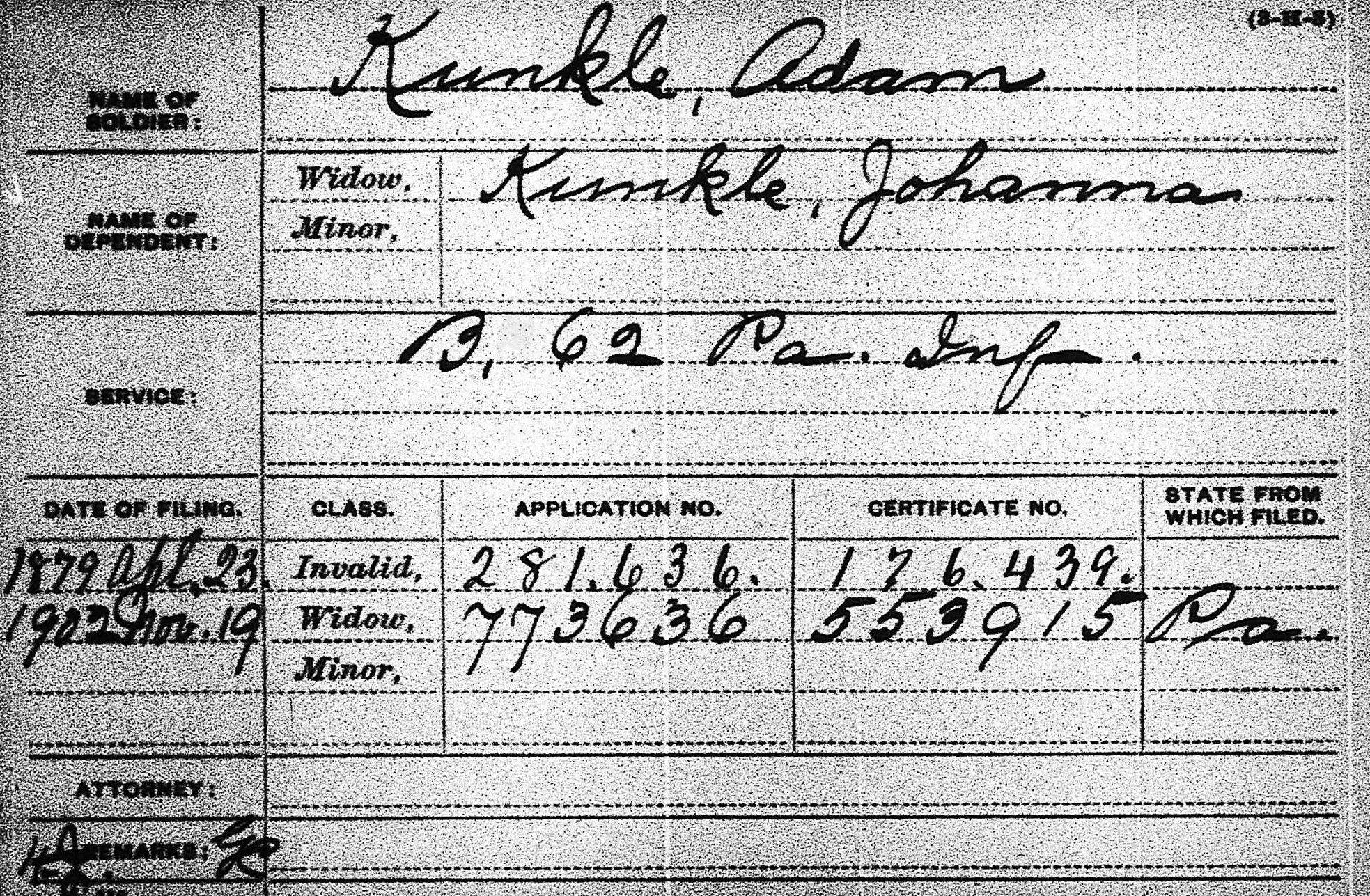Co B 62 Regt PVI - Civil War
"Cas 81. — Private A. Kunkle, Co. B, 62d Pennsylvania, aged 18 years, was wounded at Gettysburg, July 2, 1863, and remained at a field hospital for two weeks, when he was transferred to Baltimore. Acting Assistant Surgeon J. Dickson made the following report from Jarvis Hospital: "He was wounded through the right thigh, the missile entering near the tuberosity of the ischium, and, passing about fourteen inches through the deep muscles, emerged outside of the femur four inches from the knee. He stated that he bled very freely on the field, and after being taken to a neighboring house there was a recurrence, lasting all night. No further haemorrhage occurred until the patient was brought to this hospital. At that time he was very anaemic and feeble. Generous diet and iron were ordered. On July 17th, an alarming haemorrhage occurred from both wounds, which was arrested by compression and the local application of persulphate of iron. Two days afterwards there was another haemorrhage as profuse as before, and the same treatment was resorted to with the same result. On July 28th, there was a recurrence nearly as profuse as the last. Amputation and ligation of the femoral artery was thought of; but it was concluded he would die after either, and compression upon the femoral and along the course of the wound was resorted to. On July 30th, the patient was rallying. On August 6th, another slight haemorrhage came on, followed by a discharge of sanious pus, the contents of an aneurismal sac. By August 29th the wounds had almost healed and the patient quite built up and walking on crutches, his leg being considerably contracted but straightening gradually." In October following the patient was transferred to the Satterlee Hospital, Philadelphia, and subsequently to Pittsburg, whence he was returned to his regiment for duty February 12, 1864. The Adjutant General of Pennsylvania reports that the man was mustered out with his command July 13, 1864. He is not a pensioner." -- The Medical and Surgical History of the War of the Rebellion. Part III, Volume II. (3rd Surgical volume) by U. S. Army Surgeon General's Office, 1883.
Co B 62 Regt PVI - Civil War
"Cas 81. — Private A. Kunkle, Co. B, 62d Pennsylvania, aged 18 years, was wounded at Gettysburg, July 2, 1863, and remained at a field hospital for two weeks, when he was transferred to Baltimore. Acting Assistant Surgeon J. Dickson made the following report from Jarvis Hospital: "He was wounded through the right thigh, the missile entering near the tuberosity of the ischium, and, passing about fourteen inches through the deep muscles, emerged outside of the femur four inches from the knee. He stated that he bled very freely on the field, and after being taken to a neighboring house there was a recurrence, lasting all night. No further haemorrhage occurred until the patient was brought to this hospital. At that time he was very anaemic and feeble. Generous diet and iron were ordered. On July 17th, an alarming haemorrhage occurred from both wounds, which was arrested by compression and the local application of persulphate of iron. Two days afterwards there was another haemorrhage as profuse as before, and the same treatment was resorted to with the same result. On July 28th, there was a recurrence nearly as profuse as the last. Amputation and ligation of the femoral artery was thought of; but it was concluded he would die after either, and compression upon the femoral and along the course of the wound was resorted to. On July 30th, the patient was rallying. On August 6th, another slight haemorrhage came on, followed by a discharge of sanious pus, the contents of an aneurismal sac. By August 29th the wounds had almost healed and the patient quite built up and walking on crutches, his leg being considerably contracted but straightening gradually." In October following the patient was transferred to the Satterlee Hospital, Philadelphia, and subsequently to Pittsburg, whence he was returned to his regiment for duty February 12, 1864. The Adjutant General of Pennsylvania reports that the man was mustered out with his command July 13, 1864. He is not a pensioner." -- The Medical and Surgical History of the War of the Rebellion. Part III, Volume II. (3rd Surgical volume) by U. S. Army Surgeon General's Office, 1883.
Family Members
Sponsored by Ancestry
Advertisement
Advertisement










